University Healthcare Report: Clinical Governance and Fall Prevention
VerifiedAdded on 2023/06/03
|7
|1638
|381
Report
AI Summary
This report investigates clinical governance, focusing on fall prevention strategies in healthcare settings. It begins with an introduction to the issue, highlighting the importance of preventing falls among elderly patients in hospitals. The report then presents a critical analysis of three research articles: a randomized controlled trial on multimedia patient education, a qualitative study on senior adults' perceptions of fall prevention, and a systematic literature review on effective fall prevention strategies. The analysis includes summaries of the studies' methodologies, findings, strengths, and limitations. The report also provides a summary table of key findings from the provided assignment brief. By evaluating these studies, the report aims to identify effective approaches to prevent falls, improve nursing practices, and enhance patient outcomes within a clinical governance framework. The references used in the report are also included.
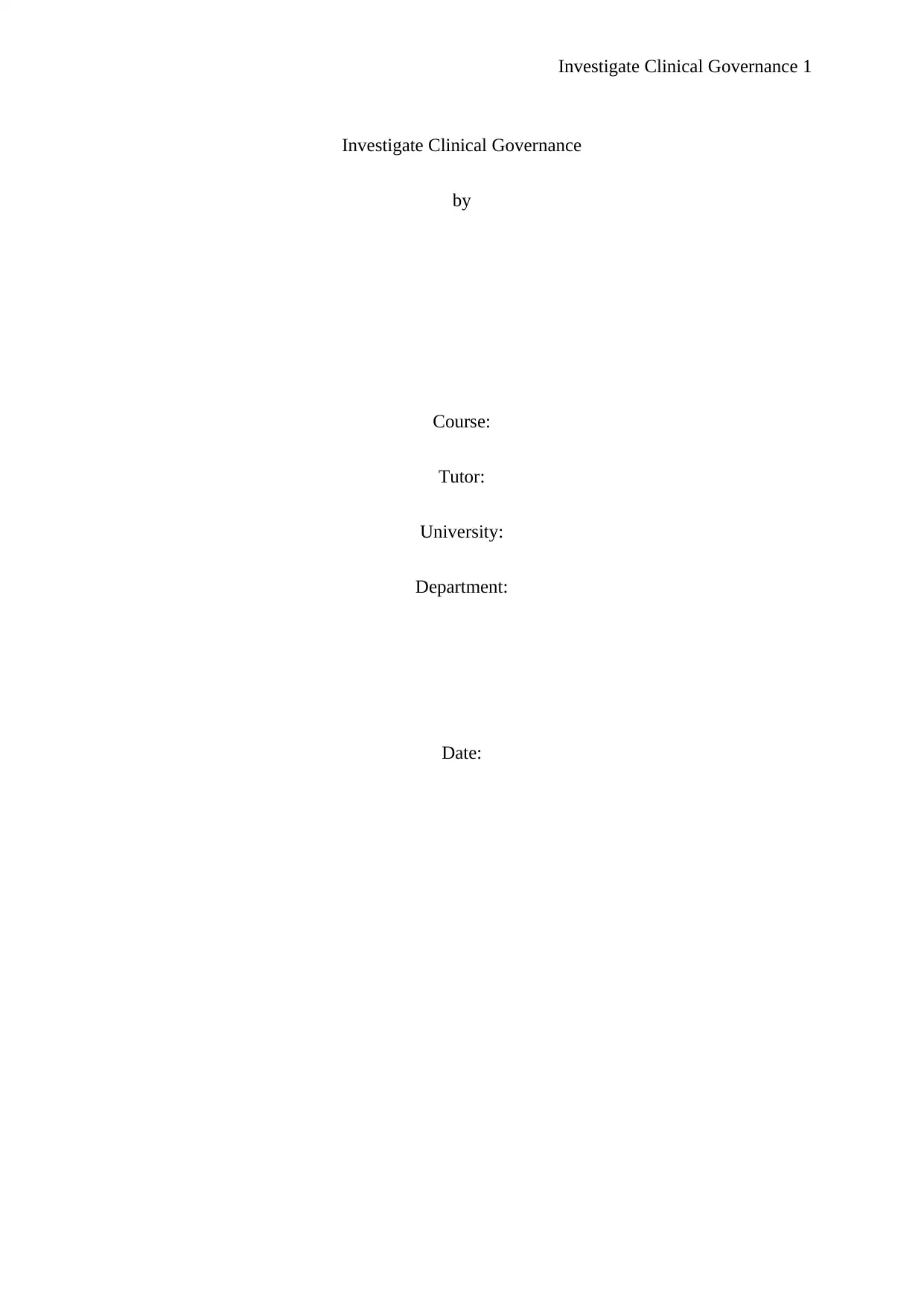
Investigate Clinical Governance 1
Investigate Clinical Governance
by
Course:
Tutor:
University:
Department:
Date:
Investigate Clinical Governance
by
Course:
Tutor:
University:
Department:
Date:
Paraphrase This Document
Need a fresh take? Get an instant paraphrase of this document with our AI Paraphraser
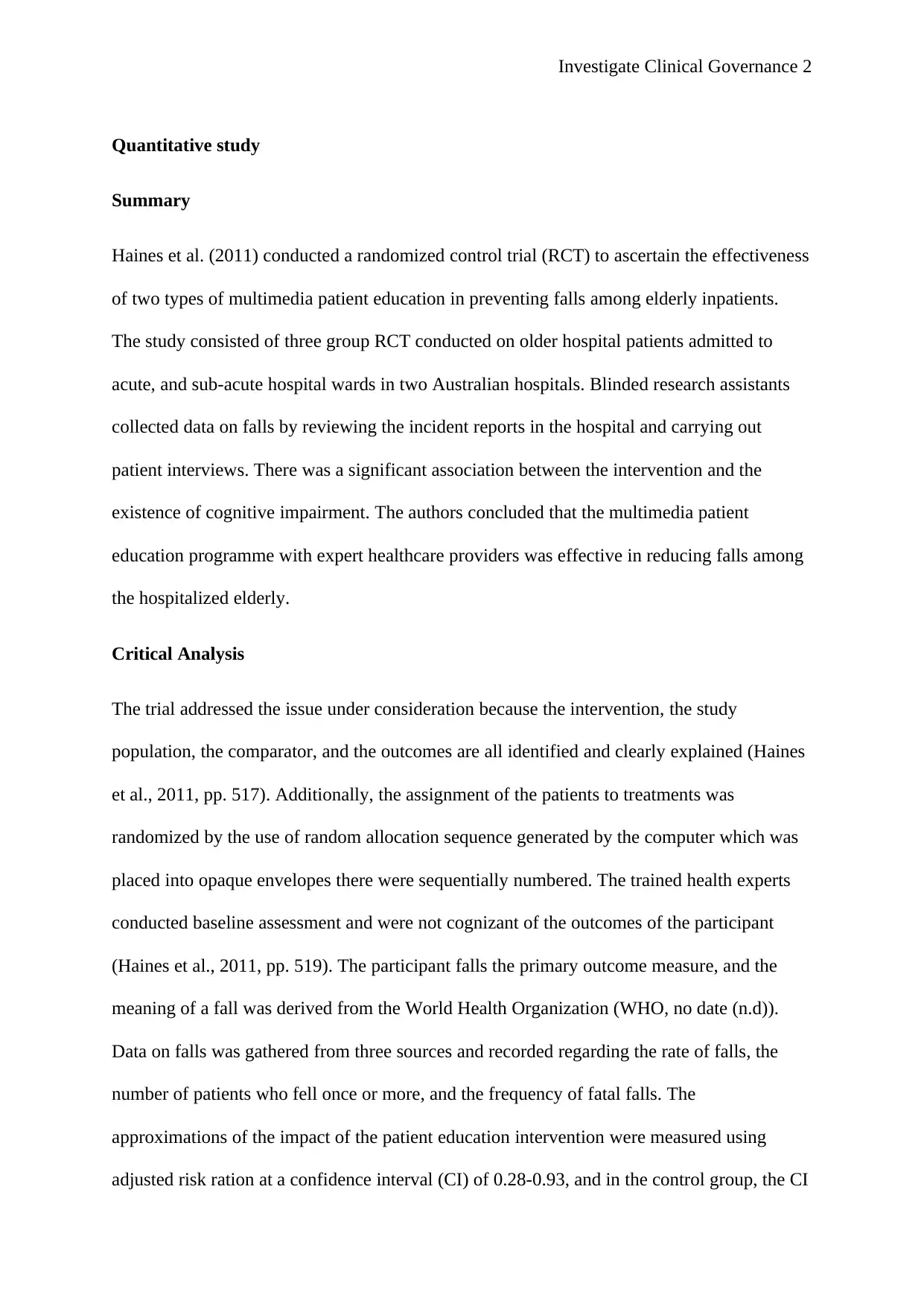
Investigate Clinical Governance 2
Quantitative study
Summary
Haines et al. (2011) conducted a randomized control trial (RCT) to ascertain the effectiveness
of two types of multimedia patient education in preventing falls among elderly inpatients.
The study consisted of three group RCT conducted on older hospital patients admitted to
acute, and sub-acute hospital wards in two Australian hospitals. Blinded research assistants
collected data on falls by reviewing the incident reports in the hospital and carrying out
patient interviews. There was a significant association between the intervention and the
existence of cognitive impairment. The authors concluded that the multimedia patient
education programme with expert healthcare providers was effective in reducing falls among
the hospitalized elderly.
Critical Analysis
The trial addressed the issue under consideration because the intervention, the study
population, the comparator, and the outcomes are all identified and clearly explained (Haines
et al., 2011, pp. 517). Additionally, the assignment of the patients to treatments was
randomized by the use of random allocation sequence generated by the computer which was
placed into opaque envelopes there were sequentially numbered. The trained health experts
conducted baseline assessment and were not cognizant of the outcomes of the participant
(Haines et al., 2011, pp. 519). The participant falls the primary outcome measure, and the
meaning of a fall was derived from the World Health Organization (WHO, no date (n.d)).
Data on falls was gathered from three sources and recorded regarding the rate of falls, the
number of patients who fell once or more, and the frequency of fatal falls. The
approximations of the impact of the patient education intervention were measured using
adjusted risk ration at a confidence interval (CI) of 0.28-0.93, and in the control group, the CI
Quantitative study
Summary
Haines et al. (2011) conducted a randomized control trial (RCT) to ascertain the effectiveness
of two types of multimedia patient education in preventing falls among elderly inpatients.
The study consisted of three group RCT conducted on older hospital patients admitted to
acute, and sub-acute hospital wards in two Australian hospitals. Blinded research assistants
collected data on falls by reviewing the incident reports in the hospital and carrying out
patient interviews. There was a significant association between the intervention and the
existence of cognitive impairment. The authors concluded that the multimedia patient
education programme with expert healthcare providers was effective in reducing falls among
the hospitalized elderly.
Critical Analysis
The trial addressed the issue under consideration because the intervention, the study
population, the comparator, and the outcomes are all identified and clearly explained (Haines
et al., 2011, pp. 517). Additionally, the assignment of the patients to treatments was
randomized by the use of random allocation sequence generated by the computer which was
placed into opaque envelopes there were sequentially numbered. The trained health experts
conducted baseline assessment and were not cognizant of the outcomes of the participant
(Haines et al., 2011, pp. 519). The participant falls the primary outcome measure, and the
meaning of a fall was derived from the World Health Organization (WHO, no date (n.d)).
Data on falls was gathered from three sources and recorded regarding the rate of falls, the
number of patients who fell once or more, and the frequency of fatal falls. The
approximations of the impact of the patient education intervention were measured using
adjusted risk ration at a confidence interval (CI) of 0.28-0.93, and in the control group, the CI
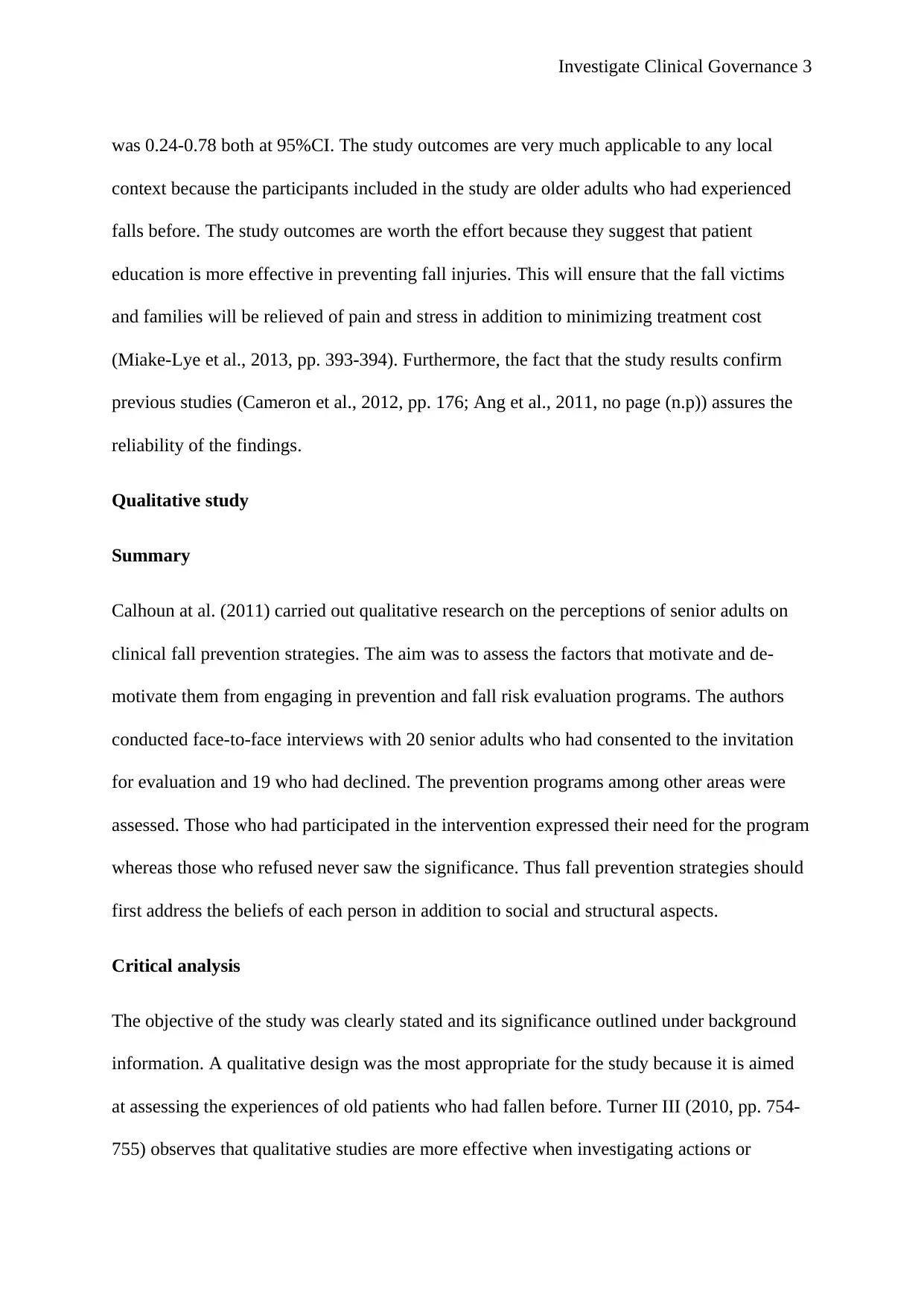
Investigate Clinical Governance 3
was 0.24-0.78 both at 95%CI. The study outcomes are very much applicable to any local
context because the participants included in the study are older adults who had experienced
falls before. The study outcomes are worth the effort because they suggest that patient
education is more effective in preventing fall injuries. This will ensure that the fall victims
and families will be relieved of pain and stress in addition to minimizing treatment cost
(Miake-Lye et al., 2013, pp. 393-394). Furthermore, the fact that the study results confirm
previous studies (Cameron et al., 2012, pp. 176; Ang et al., 2011, no page (n.p)) assures the
reliability of the findings.
Qualitative study
Summary
Calhoun at al. (2011) carried out qualitative research on the perceptions of senior adults on
clinical fall prevention strategies. The aim was to assess the factors that motivate and de-
motivate them from engaging in prevention and fall risk evaluation programs. The authors
conducted face-to-face interviews with 20 senior adults who had consented to the invitation
for evaluation and 19 who had declined. The prevention programs among other areas were
assessed. Those who had participated in the intervention expressed their need for the program
whereas those who refused never saw the significance. Thus fall prevention strategies should
first address the beliefs of each person in addition to social and structural aspects.
Critical analysis
The objective of the study was clearly stated and its significance outlined under background
information. A qualitative design was the most appropriate for the study because it is aimed
at assessing the experiences of old patients who had fallen before. Turner III (2010, pp. 754-
755) observes that qualitative studies are more effective when investigating actions or
was 0.24-0.78 both at 95%CI. The study outcomes are very much applicable to any local
context because the participants included in the study are older adults who had experienced
falls before. The study outcomes are worth the effort because they suggest that patient
education is more effective in preventing fall injuries. This will ensure that the fall victims
and families will be relieved of pain and stress in addition to minimizing treatment cost
(Miake-Lye et al., 2013, pp. 393-394). Furthermore, the fact that the study results confirm
previous studies (Cameron et al., 2012, pp. 176; Ang et al., 2011, no page (n.p)) assures the
reliability of the findings.
Qualitative study
Summary
Calhoun at al. (2011) carried out qualitative research on the perceptions of senior adults on
clinical fall prevention strategies. The aim was to assess the factors that motivate and de-
motivate them from engaging in prevention and fall risk evaluation programs. The authors
conducted face-to-face interviews with 20 senior adults who had consented to the invitation
for evaluation and 19 who had declined. The prevention programs among other areas were
assessed. Those who had participated in the intervention expressed their need for the program
whereas those who refused never saw the significance. Thus fall prevention strategies should
first address the beliefs of each person in addition to social and structural aspects.
Critical analysis
The objective of the study was clearly stated and its significance outlined under background
information. A qualitative design was the most appropriate for the study because it is aimed
at assessing the experiences of old patients who had fallen before. Turner III (2010, pp. 754-
755) observes that qualitative studies are more effective when investigating actions or
⊘ This is a preview!⊘
Do you want full access?
Subscribe today to unlock all pages.

Trusted by 1+ million students worldwide
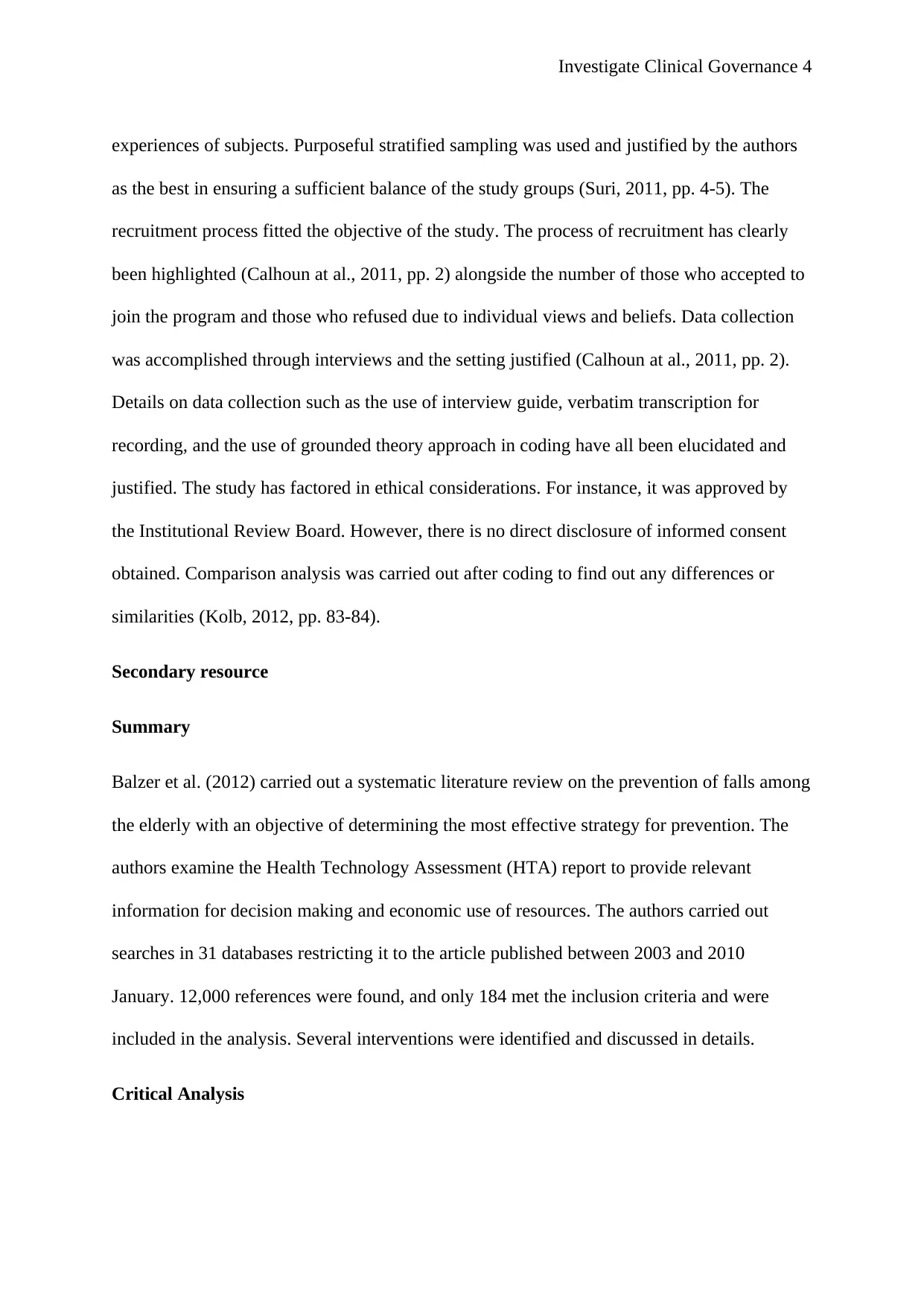
Investigate Clinical Governance 4
experiences of subjects. Purposeful stratified sampling was used and justified by the authors
as the best in ensuring a sufficient balance of the study groups (Suri, 2011, pp. 4-5). The
recruitment process fitted the objective of the study. The process of recruitment has clearly
been highlighted (Calhoun at al., 2011, pp. 2) alongside the number of those who accepted to
join the program and those who refused due to individual views and beliefs. Data collection
was accomplished through interviews and the setting justified (Calhoun at al., 2011, pp. 2).
Details on data collection such as the use of interview guide, verbatim transcription for
recording, and the use of grounded theory approach in coding have all been elucidated and
justified. The study has factored in ethical considerations. For instance, it was approved by
the Institutional Review Board. However, there is no direct disclosure of informed consent
obtained. Comparison analysis was carried out after coding to find out any differences or
similarities (Kolb, 2012, pp. 83-84).
Secondary resource
Summary
Balzer et al. (2012) carried out a systematic literature review on the prevention of falls among
the elderly with an objective of determining the most effective strategy for prevention. The
authors examine the Health Technology Assessment (HTA) report to provide relevant
information for decision making and economic use of resources. The authors carried out
searches in 31 databases restricting it to the article published between 2003 and 2010
January. 12,000 references were found, and only 184 met the inclusion criteria and were
included in the analysis. Several interventions were identified and discussed in details.
Critical Analysis
experiences of subjects. Purposeful stratified sampling was used and justified by the authors
as the best in ensuring a sufficient balance of the study groups (Suri, 2011, pp. 4-5). The
recruitment process fitted the objective of the study. The process of recruitment has clearly
been highlighted (Calhoun at al., 2011, pp. 2) alongside the number of those who accepted to
join the program and those who refused due to individual views and beliefs. Data collection
was accomplished through interviews and the setting justified (Calhoun at al., 2011, pp. 2).
Details on data collection such as the use of interview guide, verbatim transcription for
recording, and the use of grounded theory approach in coding have all been elucidated and
justified. The study has factored in ethical considerations. For instance, it was approved by
the Institutional Review Board. However, there is no direct disclosure of informed consent
obtained. Comparison analysis was carried out after coding to find out any differences or
similarities (Kolb, 2012, pp. 83-84).
Secondary resource
Summary
Balzer et al. (2012) carried out a systematic literature review on the prevention of falls among
the elderly with an objective of determining the most effective strategy for prevention. The
authors examine the Health Technology Assessment (HTA) report to provide relevant
information for decision making and economic use of resources. The authors carried out
searches in 31 databases restricting it to the article published between 2003 and 2010
January. 12,000 references were found, and only 184 met the inclusion criteria and were
included in the analysis. Several interventions were identified and discussed in details.
Critical Analysis
Paraphrase This Document
Need a fresh take? Get an instant paraphrase of this document with our AI Paraphraser
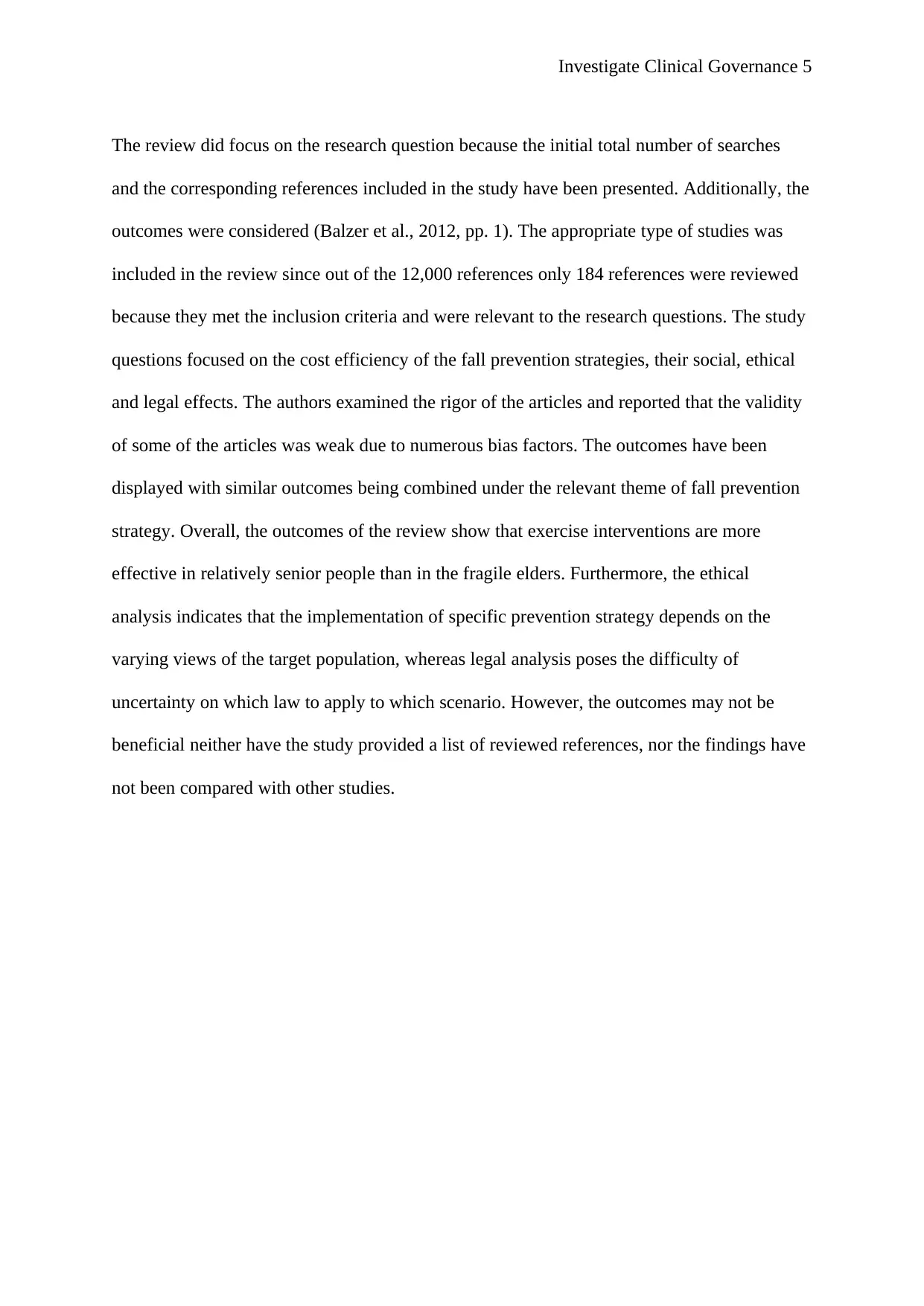
Investigate Clinical Governance 5
The review did focus on the research question because the initial total number of searches
and the corresponding references included in the study have been presented. Additionally, the
outcomes were considered (Balzer et al., 2012, pp. 1). The appropriate type of studies was
included in the review since out of the 12,000 references only 184 references were reviewed
because they met the inclusion criteria and were relevant to the research questions. The study
questions focused on the cost efficiency of the fall prevention strategies, their social, ethical
and legal effects. The authors examined the rigor of the articles and reported that the validity
of some of the articles was weak due to numerous bias factors. The outcomes have been
displayed with similar outcomes being combined under the relevant theme of fall prevention
strategy. Overall, the outcomes of the review show that exercise interventions are more
effective in relatively senior people than in the fragile elders. Furthermore, the ethical
analysis indicates that the implementation of specific prevention strategy depends on the
varying views of the target population, whereas legal analysis poses the difficulty of
uncertainty on which law to apply to which scenario. However, the outcomes may not be
beneficial neither have the study provided a list of reviewed references, nor the findings have
not been compared with other studies.
The review did focus on the research question because the initial total number of searches
and the corresponding references included in the study have been presented. Additionally, the
outcomes were considered (Balzer et al., 2012, pp. 1). The appropriate type of studies was
included in the review since out of the 12,000 references only 184 references were reviewed
because they met the inclusion criteria and were relevant to the research questions. The study
questions focused on the cost efficiency of the fall prevention strategies, their social, ethical
and legal effects. The authors examined the rigor of the articles and reported that the validity
of some of the articles was weak due to numerous bias factors. The outcomes have been
displayed with similar outcomes being combined under the relevant theme of fall prevention
strategy. Overall, the outcomes of the review show that exercise interventions are more
effective in relatively senior people than in the fragile elders. Furthermore, the ethical
analysis indicates that the implementation of specific prevention strategy depends on the
varying views of the target population, whereas legal analysis poses the difficulty of
uncertainty on which law to apply to which scenario. However, the outcomes may not be
beneficial neither have the study provided a list of reviewed references, nor the findings have
not been compared with other studies.
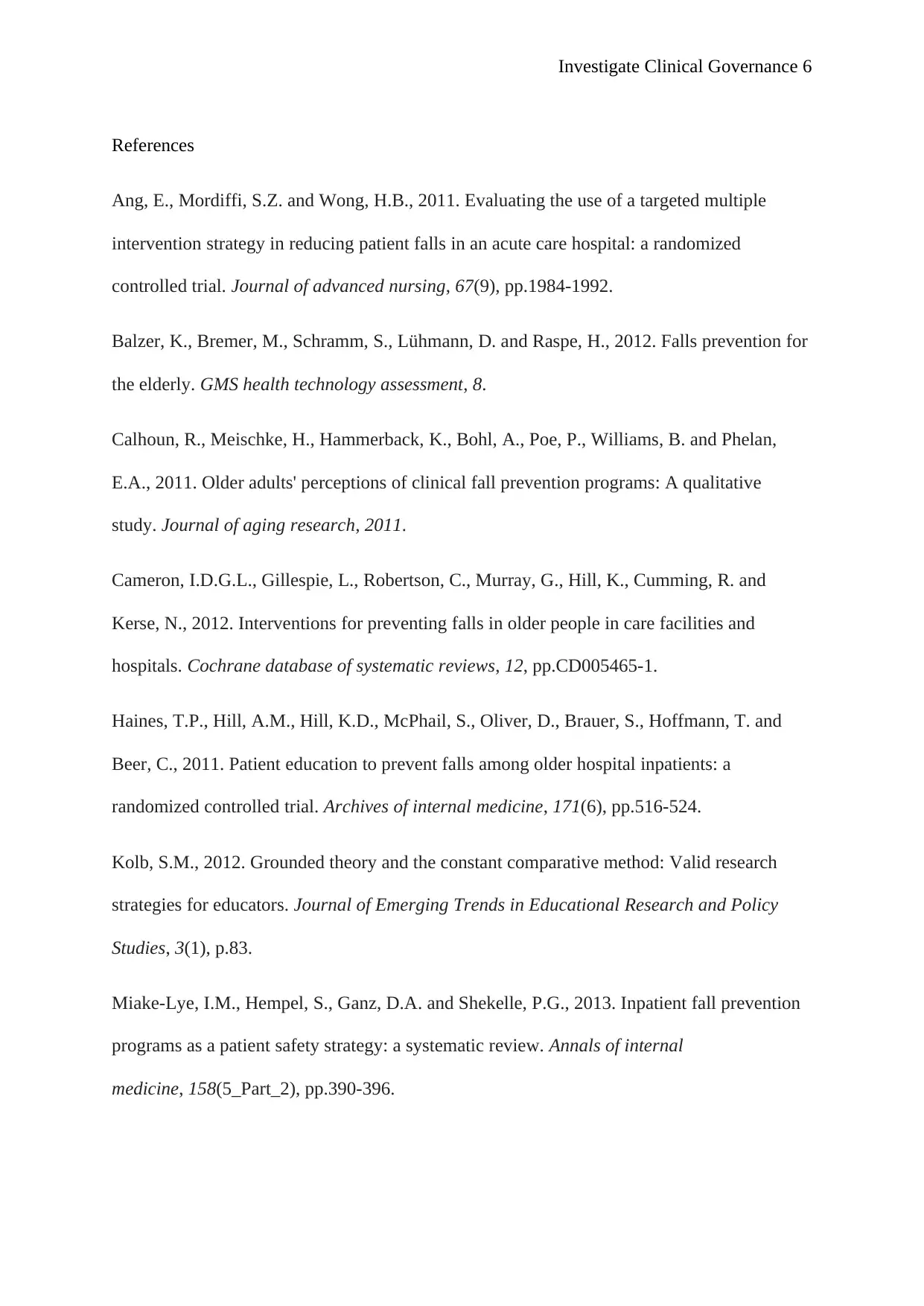
Investigate Clinical Governance 6
References
Ang, E., Mordiffi, S.Z. and Wong, H.B., 2011. Evaluating the use of a targeted multiple
intervention strategy in reducing patient falls in an acute care hospital: a randomized
controlled trial. Journal of advanced nursing, 67(9), pp.1984-1992.
Balzer, K., Bremer, M., Schramm, S., Lühmann, D. and Raspe, H., 2012. Falls prevention for
the elderly. GMS health technology assessment, 8.
Calhoun, R., Meischke, H., Hammerback, K., Bohl, A., Poe, P., Williams, B. and Phelan,
E.A., 2011. Older adults' perceptions of clinical fall prevention programs: A qualitative
study. Journal of aging research, 2011.
Cameron, I.D.G.L., Gillespie, L., Robertson, C., Murray, G., Hill, K., Cumming, R. and
Kerse, N., 2012. Interventions for preventing falls in older people in care facilities and
hospitals. Cochrane database of systematic reviews, 12, pp.CD005465-1.
Haines, T.P., Hill, A.M., Hill, K.D., McPhail, S., Oliver, D., Brauer, S., Hoffmann, T. and
Beer, C., 2011. Patient education to prevent falls among older hospital inpatients: a
randomized controlled trial. Archives of internal medicine, 171(6), pp.516-524.
Kolb, S.M., 2012. Grounded theory and the constant comparative method: Valid research
strategies for educators. Journal of Emerging Trends in Educational Research and Policy
Studies, 3(1), p.83.
Miake-Lye, I.M., Hempel, S., Ganz, D.A. and Shekelle, P.G., 2013. Inpatient fall prevention
programs as a patient safety strategy: a systematic review. Annals of internal
medicine, 158(5_Part_2), pp.390-396.
References
Ang, E., Mordiffi, S.Z. and Wong, H.B., 2011. Evaluating the use of a targeted multiple
intervention strategy in reducing patient falls in an acute care hospital: a randomized
controlled trial. Journal of advanced nursing, 67(9), pp.1984-1992.
Balzer, K., Bremer, M., Schramm, S., Lühmann, D. and Raspe, H., 2012. Falls prevention for
the elderly. GMS health technology assessment, 8.
Calhoun, R., Meischke, H., Hammerback, K., Bohl, A., Poe, P., Williams, B. and Phelan,
E.A., 2011. Older adults' perceptions of clinical fall prevention programs: A qualitative
study. Journal of aging research, 2011.
Cameron, I.D.G.L., Gillespie, L., Robertson, C., Murray, G., Hill, K., Cumming, R. and
Kerse, N., 2012. Interventions for preventing falls in older people in care facilities and
hospitals. Cochrane database of systematic reviews, 12, pp.CD005465-1.
Haines, T.P., Hill, A.M., Hill, K.D., McPhail, S., Oliver, D., Brauer, S., Hoffmann, T. and
Beer, C., 2011. Patient education to prevent falls among older hospital inpatients: a
randomized controlled trial. Archives of internal medicine, 171(6), pp.516-524.
Kolb, S.M., 2012. Grounded theory and the constant comparative method: Valid research
strategies for educators. Journal of Emerging Trends in Educational Research and Policy
Studies, 3(1), p.83.
Miake-Lye, I.M., Hempel, S., Ganz, D.A. and Shekelle, P.G., 2013. Inpatient fall prevention
programs as a patient safety strategy: a systematic review. Annals of internal
medicine, 158(5_Part_2), pp.390-396.
⊘ This is a preview!⊘
Do you want full access?
Subscribe today to unlock all pages.

Trusted by 1+ million students worldwide
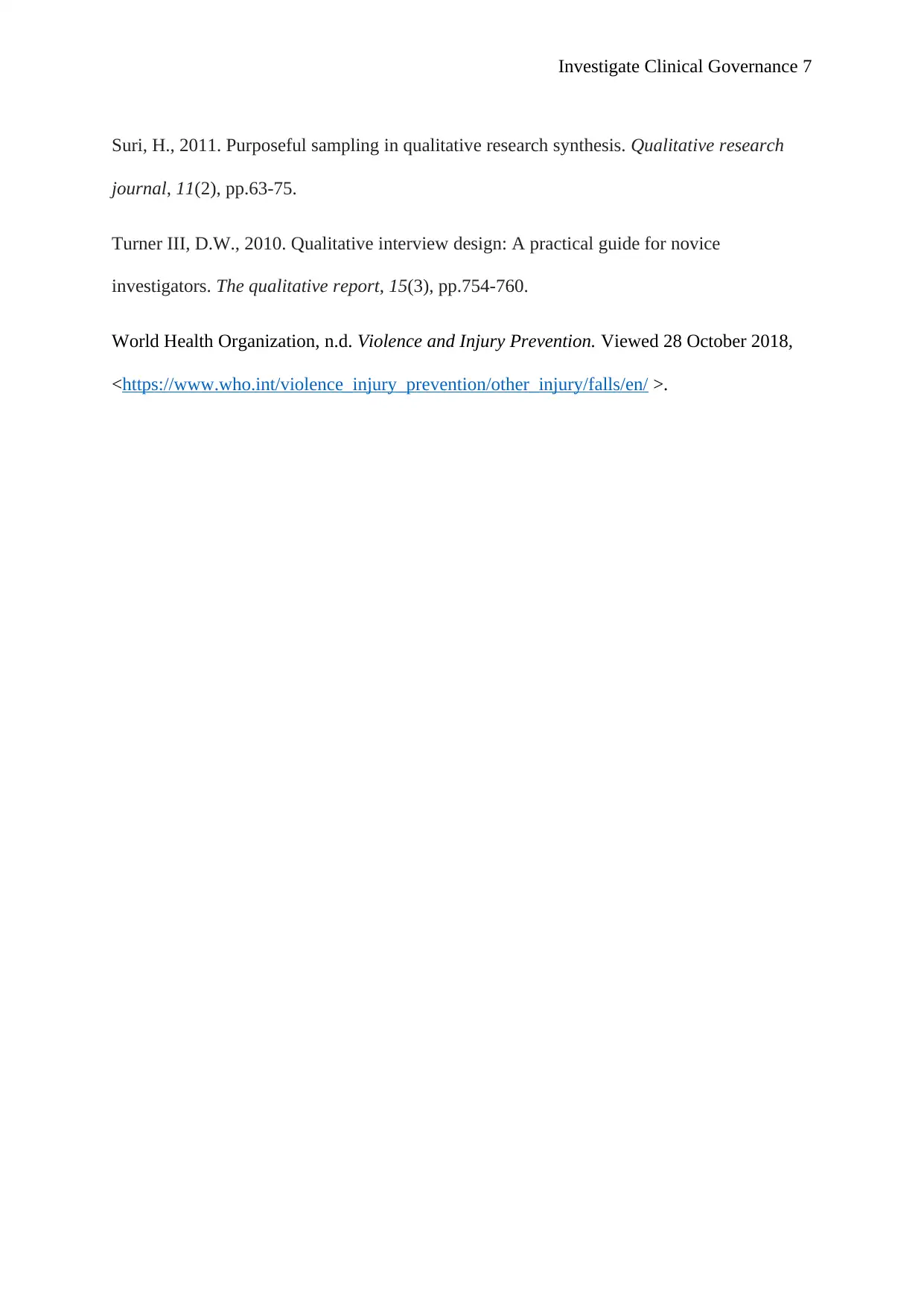
Investigate Clinical Governance 7
Suri, H., 2011. Purposeful sampling in qualitative research synthesis. Qualitative research
journal, 11(2), pp.63-75.
Turner III, D.W., 2010. Qualitative interview design: A practical guide for novice
investigators. The qualitative report, 15(3), pp.754-760.
World Health Organization, n.d. Violence and Injury Prevention. Viewed 28 October 2018,
<https://www.who.int/violence_injury_prevention/other_injury/falls/en/ >.
Suri, H., 2011. Purposeful sampling in qualitative research synthesis. Qualitative research
journal, 11(2), pp.63-75.
Turner III, D.W., 2010. Qualitative interview design: A practical guide for novice
investigators. The qualitative report, 15(3), pp.754-760.
World Health Organization, n.d. Violence and Injury Prevention. Viewed 28 October 2018,
<https://www.who.int/violence_injury_prevention/other_injury/falls/en/ >.
1 out of 7
Related Documents
Your All-in-One AI-Powered Toolkit for Academic Success.
+13062052269
info@desklib.com
Available 24*7 on WhatsApp / Email
![[object Object]](/_next/static/media/star-bottom.7253800d.svg)
Unlock your academic potential
Copyright © 2020–2025 A2Z Services. All Rights Reserved. Developed and managed by ZUCOL.





